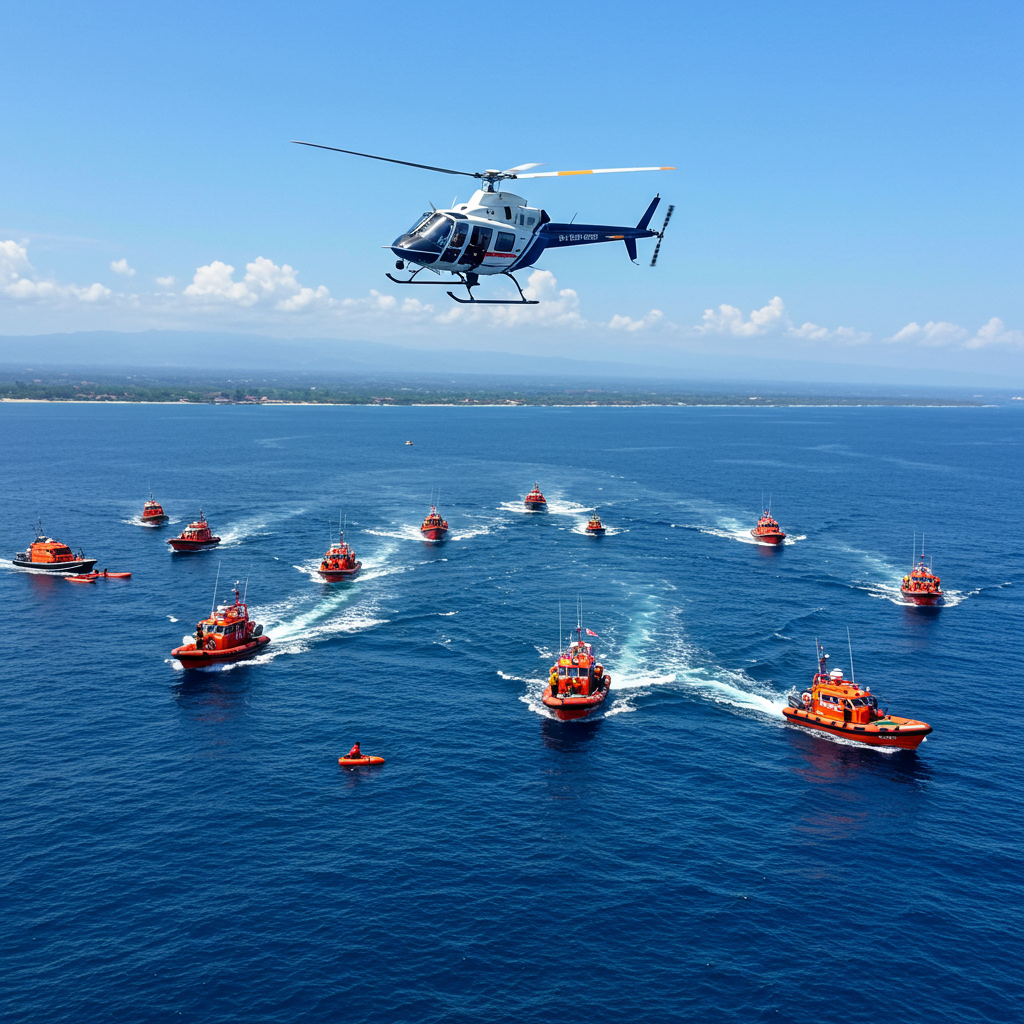A desperate search and rescue operation is actively underway off the coast of Indonesia near the popular tourist island of Bali. Authorities and volunteers are racing against time, scouring the waters following the sinking of a passenger and vehicle ferry late Wednesday night. The maritime tragedy has gripped the nation, leaving families in anguish as the fate of dozens remains unknown.
As of Thursday, rescue teams confirmed they were searching for 29 people still missing after the vessel went down. The incident has tragically claimed at least six lives, including a young child and their mother. Meanwhile, hope remains as 30 individuals have been successfully pulled from the sea, many requiring immediate medical attention after enduring hours in the choppy waters.
Rescue Efforts Intensify Amid Challenging Conditions
The search-and-rescue operation is being spearheaded by Indonesia’s National Search and Rescue Agency, known locally as BASARNAS. Their efforts are concentrated on the critical area between the accident site and the intended destination port. A significant fleet of vessels, including at least 15 boats, two tug boats, and two inflatable boats, has been deployed. A helicopter is also assisting from above, providing a crucial aerial perspective.
Adding to the official response, local fishermen and residents on shore have bravely joined the search, demonstrating a strong community spirit in the face of disaster. However, rescue work has been significantly hampered by adverse weather conditions. Overnight, searchers battled strong waves reaching up to 2 meters (6.5 feet) and limited visibility due to darkness. While conditions reportedly improved slightly on Thursday morning, waves up to 2.5 meters (8.2 feet), strong currents, and gusty winds continued to pose challenges, affecting the search area. The difficult conditions caused the initial search focus to shift based on changing ocean currents, leading to victims being found in areas south of the initial location.
The Ill-Fated Journey of KMP Tunu Pratama Jaya
The vessel involved in the tragedy was the KMP Tunu Pratama Jaya. It departed from Ketapang port in Banyuwangi, East Java, late Wednesday, bound for the Gilimanuk port on Bali, a relatively short trip across the Bali Strait, reportedly spanning about 5 kilometers (3.1 miles). The sinking occurred approximately half an hour after it left port.
According to the manifest, the ferry was carrying a total of 65 people, comprising 53 passengers and 12 crew members. In addition to the people on board, the ferry was transporting 22 vehicles, including 14 trucks. This combination of passengers and heavy cargo is common on these busy inter-island routes.
The moments leading up to the sinking were witnessed by an on-duty officer at the departure port. Initial attempts to contact the ferry via radio were unsuccessful. Contact was eventually made through other ships from the same company, but by that point, the KMP Tunu Pratama Jaya was already reported to be in a severe “tilting condition.”
Harrowing Accounts from Survivors
Survivors have shared terrifying accounts of the rapid sinking. One survivor, Supardi, 64, recounted how he intended to jump into the sea as the vessel began to list. However, the ferry sank so quickly that he was pulled underwater to a depth of about 7 meters (23 feet). He managed to fight his way back to the surface and, along with three others, used life jackets to stay afloat for hours in the rough seas before being rescued.
Another survivor, Eka Toniansyah, described the frightening speed of the event, stating the ferry “tilted and immediately sank.” Tragically, he also shared the personal loss of his father in the disaster. Many of those rescued were found unconscious, a testament to the ordeal they endured drifting in the cold, turbulent waters.
Investigating Potential Causes
Authorities have launched an immediate investigation into the cause of the tragic accident. While challenging weather conditions were clearly a factor, initial reports and survivor accounts suggest other potential issues.
Some survivors told rescuers they believed there may have been a leak in the ferry’s engine room before it sank. The head of the Surabaya Search and Rescue agency, Nanang Sigit, confirmed that the vessel is now fully submerged. He acknowledged the possibility that some individuals might be trapped inside the wreckage, although the primary search efforts remain focused on the water’s surface where most victims have been found. Indonesia’s Cabinet Secretary, Teddy Indra Wijaya, later attributed the preliminary cause of the disaster specifically to “bad weather.” The official investigation will need to determine if weather was the sole factor or if mechanical issues or other factors contributed to the sinking.
Maritime Safety: A Recurring Issue in Indonesia
Tragically, ferry accidents are a frequent occurrence in Indonesia. As the world’s largest archipelago nation, comprising more than 17,000 islands, sea transport is a fundamental lifeline for both people and goods. However, this reliance is often underscored by concerns over maritime safety.
Critics and officials point to factors such as lax safety standards, inadequate maintenance of aging vessels, and the dangerous practice of overloading ferries beyond their official capacity as contributing factors to these recurring disasters. Many vessels may also lack sufficient life-saving equipment like life jackets or lifeboats for all passengers on board. The sinking off Bali follows other recent incidents, including a boat capsizing off Bali in March 2025 and a major ferry disaster in 2018 on Sumatra island’s Lake Toba that claimed over 150 lives, highlighting the systemic challenges in ensuring safe sea travel across the vast archipelago.
Community Impact and Official Response
The sinking has caused immense distress among the families of those who were on board. Relatives gathered in panic at the departure port in Ketapang, desperately seeking information and holding onto hope that their loved ones were among the survivors.
Those rescued have been transported to nearby medical facilities for treatment, including the Jembrana Regional Hospital in Bali and the port office in Gilimanuk, receiving care after their traumatic experience.
Indonesia’s President Prabowo Subianto, though traveling abroad in Saudi Arabia at the time of the incident, immediately ordered an emergency response to the disaster. The swift directive underscores the national significance and urgency placed on the search-and-rescue operation. Rescue efforts were temporarily suspended on Thursday evening due to poor visibility but were scheduled to resume with full force on Friday morning, continuing the critical search for the missing.
Frequently Asked Questions
What was the name of the ferry involved and its route?
The ferry that sank was the KMP Tunu Pratama Jaya. It was traveling a short distance across the Bali Strait, having departed from Ketapang port in Banyuwangi, East Java, and bound for Gilimanuk port on the island of Bali. The trip was intended to take approximately 30 minutes.
How many people were on board the ferry, and what is the latest count of rescued, missing, and deceased?
According to the official manifest, the KMP Tunu Pratama Jaya was carrying a total of 65 people, including 53 passengers and 12 crew members. As of Thursday, search efforts had resulted in the rescue of 30 individuals, the recovery of six bodies (including a child and mother), and 29 people remaining missing and unaccounted for.
What caused the ferry to sink, based on initial reports?
While the investigation is ongoing, initial reports point to a combination of factors. Survivor accounts suggest there may have been a leak in the engine room. Additionally, challenging weather conditions, including strong waves, currents, and winds, were present at the time and were cited by an official as the preliminary cause of the accident.
Conclusion: A Nation Watches and Waits
The sinking of the KMP Tunu Pratama Jaya serves as a somber reminder of the inherent risks in maritime travel, particularly in regions heavily reliant on ferry transport. As the search enters a critical phase, the focus remains squarely on locating the 29 missing individuals and providing support to the survivors and grieving families. The tragedy also renews calls for stricter enforcement of safety regulations across Indonesia’s vast ferry network to prevent future loss of life at sea. The official investigation into the precise cause of the sinking will continue, hopefully providing answers and potentially leading to measures to improve safety standards on these vital routes.
Word Count Check: 1164 words



